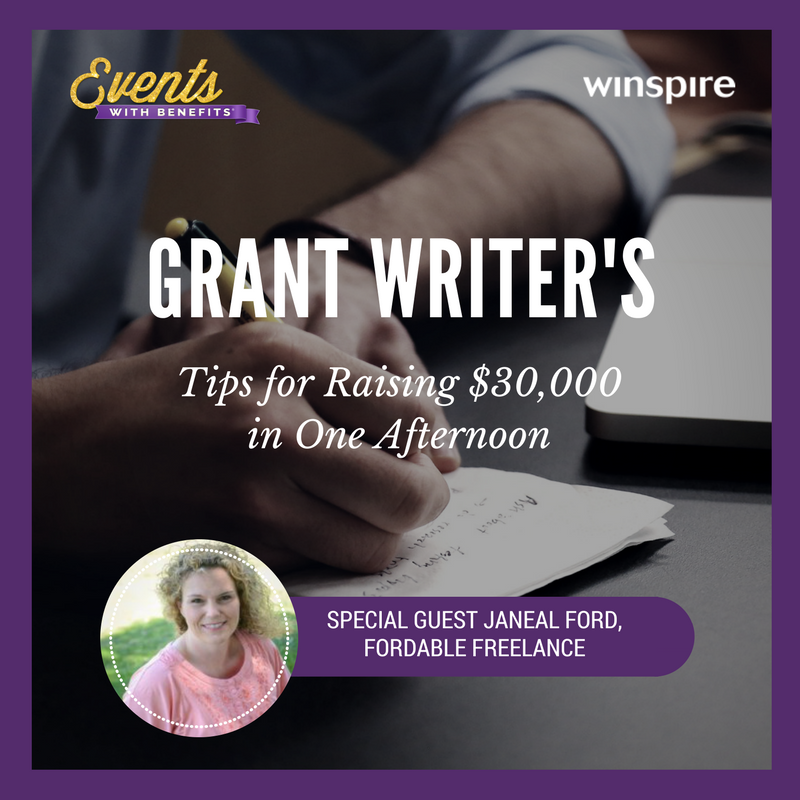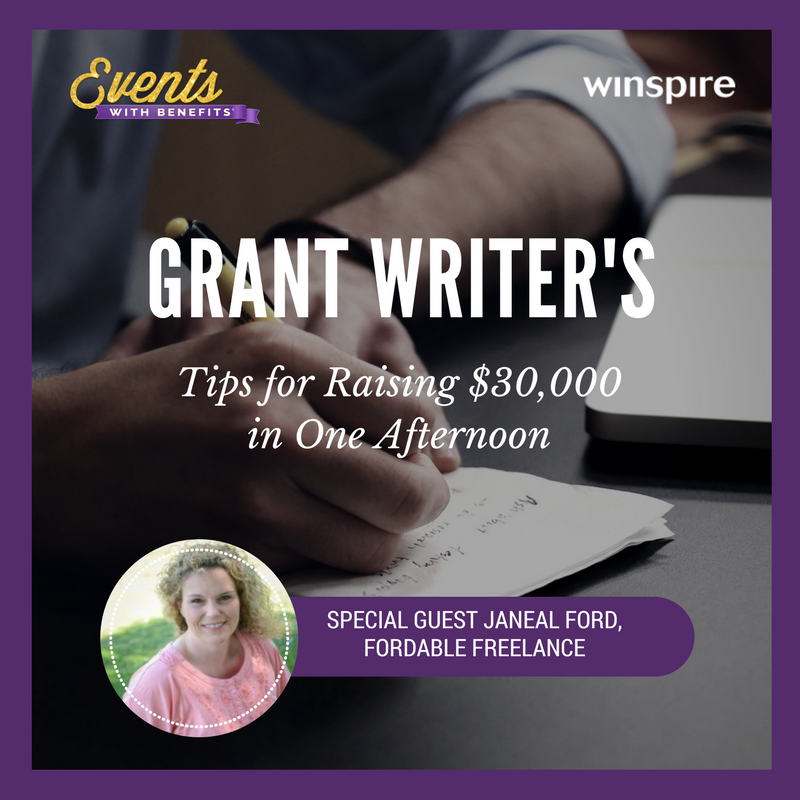One of the keys to a successful development strategy is having diverse sources of income. We most frequently discuss event fundraising, but it’s wise to have several fundraising “arms” so the loss or decline of one source won’t hamper day-to-day operations. Other opportunities include annual fundraising drives, regular or monthly giving, and one we’ll cover today: writing grants.
Is grant writing part of your development strategy?
“Planning an event to bring in $30,000 can take months. I can write a grant worth $30,000 in an afternoon,” asserts Janeal Ford, President at Fordable Freelance and professional fundraising consultant, and a recent guest on our critically-acclaimed fundraising podcast Events with Benefits.
Drawing from 20 years of grant writing experience, Ford provides concrete tips for beginners to write impactful, strategic and time-efficient grant proposals.
Grant Writing: A Key Player in Your Fundraising Team
Ford shares a recent experience with a friend in the nonprofit industry that might sound familiar…
“Last week, I went to lunch with a friend who had started working on the board of an adoption agency. She was named the chair of their upcoming gala, and she worked hard with staff to put the event together. She’s incredibly passionate about the cause, but right from the start she experienced all kinds of resistance. Little decisions like the name of the event, the band and the entertainment became big drawn-out discussions.
“Thankfully, the gala turned out to be the most successful in their history, and everyone had a fabulous time. But in the past couple of meetings, my friend noted that the Board chair has said, ‘You know who we need around this table? Folks who are rich and can write out a big check.’ I’m not one of those people, so I’m looking for another place to go.”
Her friend didn’t feel appreciated or wanted, when in fact she just brought in $20,000 for the organization.
“Nonprofits need to realize fundraising is a team sport, and there’s all kinds of ways to engage in the process besides having the money to write checks,” Ford asserts. “That’s where grant writing comes in.”
What is grant writing?
Grant writing is seeking out sources – foundations, corporations and government – that align with your programs.
Who can/should apply?
In order to qualify and apply for grants, you need a fairly established infrastructure underneath your organization. “Grant writing ends up being kind of a litmus test for how well built your infrastructures and systems are,” Ford says.
Most donors request at least two years of operation; some require five or more. Why?
“They look at the grant as an investment, and many continue to make a gift year after year,” Ford says. “So they want to know you’re going to be around.”
So, if your organization has a few years under its belt and has acheived some success with your programs, grant writing is a great way to raise money.
The application process
Ford is commissioned by nonprofits across the country to handle their grant writing. “As part of my work, I do prospect search reports, or help them find grants and foundations to which they can apply for money. I’ll share their mission and location of services, then pull from numerous sources out there,” Ford says.
Grant databases
Three of her favorite databases of grant sources are Guidestar.org (free); Grant Station (subscription); and The Foundation Center.
Oftentimes profiles will convey how many assets a source has in their funds. The greater the fund, the more capacity they have to make gifts. But rather than focusing on the dollar amount, it’s smarter to find a tight alignment with your services and what they want to fund.
“The biggest criteria for finding donors that align with your mission, is where they are – their location. Time and time again I’ve seen that people give where they live. So you want donors in and around your local community.”
The other big factor in determining if a source is the right fit for your charity: the service you provide. “Fundraising is all about passion. You want to identify partners with similar passion to the work you’re doing. They’re your ‘people’,” Ford says.
If you can be a good friend, you can be a good fundraiser. Just as you take a genuine interest in your friends, who they are, and connect with them – it’s the same with your donors. And you’ll naturally connect with people with whom you have a similar mission.
Process length
The entire process, from application to approval, can take anywhere from two weeks to four months, Ford says. The average timeline she’s observed: two months.
Tips for successful grant writing
We’ve established those who grant grants, are looking for evidence that your nonprofit is healthy, sustainable and in it for the long haul.
What other information should nonprofits be collecting to demonstrate their impact?
Highlight the unmet need
“It’s about the unmet need,” Ford says. “Not how ‘cool’ they are or how flashy of a presentation you can put together. It’s about the need statement.”
To maximize chances for a successful grant application, charities need to understand and articulate how the services they provide are the solution to an unmet community need.
“I’ve been writing grants for 20 years, and every time I write a grant, I focus on a clear, concise and compelling message that ties right back to the need the charity is meeting,” Ford asserts.
Get finances straightened out
To apply for grants, you also need to have your financial documents in order. Grant writing can require many attachments, depending on the source.
“Two of the most commonly requested documents are your audit and the 9-90,” Ford explains. “So younger nonprofits sometimes struggle with those things, because they’re still figuring out all the finances and again, a sound infrastructure is key.”
Report back frequently
As far as the length of a grant, most funds are single year gifts. The only source that might do multi-year gifts is government.
That said, we also mentioned many grant donors will likely invest every year. So it’s important to build a solid relationship with those who are supplying grants. Provide regular reports on what happened with the grant and how you spent it.
“Like any donor, grant-givers will be much more likely to continue giving if they’re connected to your cause,” Ford says. “And if the impact from their gift exceeded their expectations, they might have the capacity to give even more next year.”
Restricted funds
“You can plan an event for months and bring in $30,000, or I can write a grant for $30,000 in one afternoon,” Ford says. “However, keep in mind the proceeds are restricted – you have to use the money how you say you’ll use it, and it can be slower to access the funds than a fundraising event.”
Events allow you to raise funds that are completely unrestricted and flexible for your greatest need, which many of our nonprofit partners have noted as being one of their biggest challenges in development. However, some grant donors are beginning to offer general operating support because they understand the challenges of restricted money.
Building a culture of philanthropy
Ford’s bottom line: “Fundraising is a team sport, and everyone plays a role. So I think building a culture of philanthropy should be any organization’s number one priority.”
More on Events with Benefits
This is just a taste of the invaluable tips provided in the full podcast episode with Janeal Ford.
In the full session, Ford shares the top 3 things she wishes she would have known when first starting out in grant writing, tips for successful grant partnerships, and an exclusive offer for Winspire readers featuring a free grant writing consultation with your nonprofit and board.
Check out the full podcast episode below, or visit the full site here.
{{cta(‘639b168b-df3f-4dd6-b2ef-ae20cd598be3′,’justifycenter’)}}





